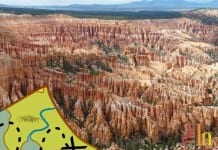
Written by Marcos Camargo
Staring in the second half of the 1970s, Utah and Nevada became the epicenter for a movement that came to be known as the Sagebrush Rebellion, so named because of the vast swaths of sagebrush steppe than covers much of the area.
Some have called the rebellion a range war, others a grassroots state’s rights movement. I prefer to call it an illegal insurrection.
Sagebrush rebels, as followers of the movement have been termed, ultimately want federally managed lands to be turned over to state control. This argument is just code for a long-term plan to sell off these lands to cattlemen, miners, and oil extraction companies—because fracking the hell out of the Black Hills isn’t enough for the corporate cause to ruin the last of our wilderness sanctuaries. Supporters of state control and private land sales argue that these businesses bring jobs and have always been the economic backbone of the West.
Both Utah and Nevada have long had economies bolstered by ranching, farming, and mining—industries where investors make the real profits and workers only get paid while resources are still plentiful (people sometimes forget that there is only so much oil, minerals, water, and arable land to go around).
So when the pro-wilderness environmental movement really started to gain ground in the 1970s, many communities based on this colonial-style economy began to feel threatened by federal acts to protect wilderness. Because why should we care if it’s really East Coast Wall Street investment firms who really profit? Let them pulverize every rock, slash every tree, frack every well, graze every chubby, delicious cow, and pour cyanide extraction solution through every grain of dirt in order to squeeze every ounce of uranium, timber, oil, beef, and gold out of our desert country—God’s country—until all that’s left is a pile of toxic mine tailings and not a tree to shade our kids from the sun.
Two events pumped sagebrush rebels with the energy they needed to bring their cause to national attention. The first was a 1977 legislative proposal introduced by newly elected Utah Senator Orrin Hatch that called for large transfers of land from federal to state control. The second was a lawsuit filed by the state of Nevada against the BLM demanding that the feds surrender land into state control.
Into the 1980s the rebellion gained ground as lawmakers in Arizona, New Mexico, Washington, Wyoming, and Alaska considered similar action.
Private citizens also took the cause into their own hands, believing that legislative action took too long. In acts termed “civil disobedience” by supporters, but that were in reality acts of vandalism and sabotage, local anti-federal rebels stopped paying grazing permit fees, rode ATVs through ecologically and culturally sensitive lands, and even destroyed BLM gates and fences with tractors.
Then, around the middle of the 1980s, the rebellion subsided, almost as quickly as it had swelled. But ironically, it’s demise came about not because of victory or defeat per se, but because, with Ronald Reagan in the White House, the executive branch simply stopped requiring miners, oilmen, farmers, and ranchers to go through a stringent permitting process. The Reagan administration also stopped the policy pursued under President Carter of continually increasing areas designated as federally protected. So the change in policy didn’t squelch the philosophy sagebrush rebels. It just put a de facto hold on both the legislative and civil disobedience actions being taken by the rebellion’s supporters.
The movement went dormant and, like a bad case of the shingles, only flared up on occasion. Then, after President Obama got into office and placed a moratorium on new fracking permits—as well as bolstered EPA regulations—the rebels quickly reinflamed their rhetoric and escalated their tactics. Once again, Utah and Nevada led the way in stirring up a new permutation of this decades-long conflict that’s been called the neo-sagebrush rebellion.
It’s made big news—both locally and nationally. And now, those who have committed crimes want you, the taxpayer, to foot the cost of their legal bills.
Cliven Bundy and his merry band of paramilitary henchman have already ripped off the American people out of over $1 million in unpaid taxes and fines.
In April 2014, when the BLM came to enforce a court order against Bundy, he fended them off with the threat of an armed conflict.
Say what you will about the tax system in the U.S., but it’s still the law and should therefore be followed by all citizens who appreciate a country that prides itself in following the rule of law. Personally, as a general rule, I oppose war. This doesn’t cause me to stop paying taxes, a large portion of which goes into America’s more than $700 billion defense budget. It’s just not the way it works if we want maintain any semblance of order.
According to a the Salt Lake Tribune, just this past week, Utah State Senator Mike Noel, a harsh critic of the BLM, looks poised to request funding from Utah’s Constitutional Defense Council to assist in appealing a federal conviction against San Juan County Commissioner Phil Lyman. Lyman’s conviction came May 1 on a charge that he organized an illegal ATV protest ride into Recapture Canyon in May 2014. The protest caused an estimated damage of $100,000 to archaeological sites in the area. Noel’s call for state-funded financial assistance comes after a federal judge already ruled that Lyman has the financial means to pay for his own defense.
So the question now is how far are most Utahns willing to go so that the state can sell off their pristine wilderness to a bunch of industrialists who only see the dollar signs in the sand and the red rock of this unique ecosystem? And do we really want our tax dollars to be spent funding a hostile range war that could have easily turned into a mini-war?
I certainly don’t.




